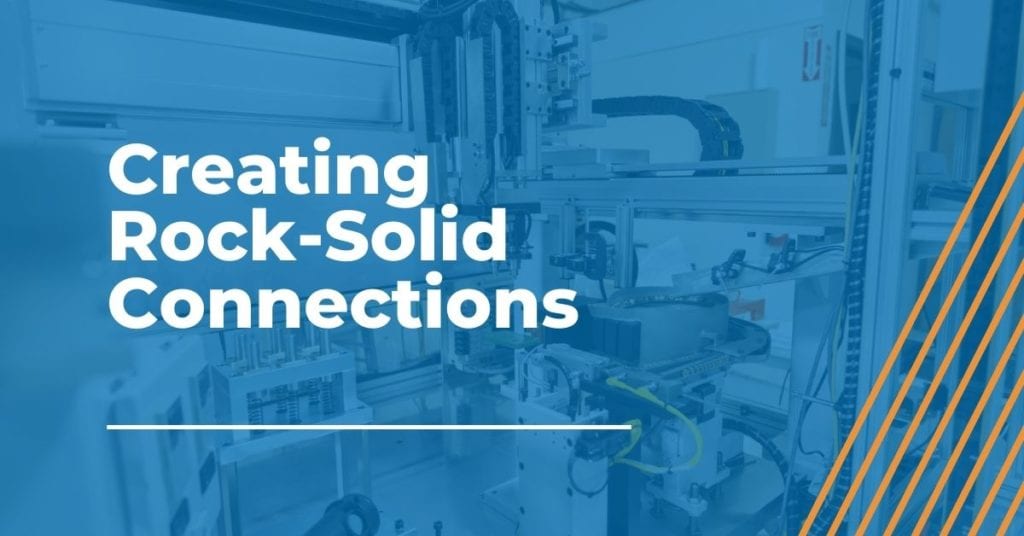
Induction Heated Nut Insertion: Information and Applications
Bonding plastic materials presents an interesting challenge to medical device manufacturers, especially in today’s world of miniaturization, weight-reduction, lifespan extension and ultra-fast times to market. Traditional methods of fusing and gluing plastics together struggle to support modern functional and cost expectations. At the same time, many manufacturers may resist investing in advanced solutions given current marketplace volatility where product lines only last a short time before they’re replaced with new variants. In this article, we’ll briefly describe the most common plastic bonding methods in medical device manufacturing, and offer our specific expertise in one of these methods: induction heated nut insertion.
Bonding Methods for Medical-Grade Plastics
Across any application, mating plastic materials together can be achieved in only a few ways: mechanical, chemical or by fusing (welding). The hygienic and resilience requirements of medical devices further limit options to a handful of solutions, which we describe below.
IR Staking
Two plastic components can be attached to each other in a similar way to riveting sheet metal. The process is known as staking. A cylindrical stake is provided in a base material’s mold, over which a second material is placed. The stake is heated up until it melts, and then is physically compressed to form a “boss” that holds down the second material. The boss serves as a permanent capped fastener.
There are multiple ways of heating the stake, such as through hot air, ultrasonic and infrared heat sources, though infrared (IR) staking is largely considered the preferred method due to cost and simplicity benefits over the alternatives. IR staking can be difficult to reconfigure for evolving applications, produces off-gassing fumes and can result in irregularities in quality due to inconsistent heat dispersion.
Adhesive Bonding
If you’re imagining glue for this option, you’d be right. Adhesive bonding is simply using a chemical compound to attach two plastics to each other, and can come in a variety of formats. Adhesive films, sprays or placed deposits can all be employed, and each has their ideal use. Films are great for temporary and accessory fastening, sprays for large area bonding and deposits for more precise non-continuous adhesion.
Any of these forms of adhesive bonding is great for low-resilience, non-structural, low-load bonding, or where light weight, full encapsulation or hygienic requirements may be priorities. The cost of adhesive delivery and application systems, surface preparation, environmental containment and quality control tend to limit this realm of solutions to rather specific applications.
Nut Insertion
Structurally sound, high-load, reusable attachment in medical devices is largely only achievable by using traditional threaded fasteners. The modern method of introducing threaded fasteners into plastic molded or machined products is to heat and insert a nut into the plastic mold itself, fully and permanently infusing an attachment point into which a threaded stud, bolt or screw can be inserted. This bonding method provides a host of benefits: strong, resilient, reusable fastening bases that offer hygienic and cleanable profiles, in that they’re melted directly into the base plastic.
With induction heated nut insertion, a wide variety of material types, thread sizes and specifications, and orientations can be used and even combined in the same assembly. Inserted nuts do add weight and (typically) introduce metallic materials into the equation, and so this method is best utilized for applications where strength and functionality are paramount.
Of these three plastic bonding methods, nut insertion offers the higher performance-to-cost ratio, as well as the most flexibility for both applications and manufacturing methods in the medical device field.
AMS has proven expertise in automating each of these bonding processes across multiple industries, with specific knowledge and proprietary technology in nut insertion.
AMS’s Induction Heated Nut Insertion Technology
The process of nut insertion technology is fairly straightforward and follows these overall steps:
- Heat a metallic nut.
- Physically press the nut into the plastic substrate.
- Precisely cool the assembly.
- Confirm the insertion was successful.
Each step however, includes another dozen sub-steps or more, all of which can make or break the strength, repeatability and cycle time of the insertion process. Automating and regulating the process is where AMS’s deep application expertise shines through.
The AMS NI-401 Automated Nut Insertion Machine platform offers an application-driven solution customized to your products’ specific needs. In addition to our machinery solutions, AMS can assist with manufacturing process design, pre- and post-insertion handling to maximize throughput, and overall line automation and fabrication front to back. Several key benefits of our nut insertion expertise in plastic medical device bonding include:
- Induction coils: Our induction heating coils are 100 percent custom-made for every application, designed for each project and position’s particular material, structural load, orientation and insertion rate.
- Heating/cooling profiles: We engineer, test and optimize precisely controlled heating and cooling gradients intended to optimally solidify plastics and prevent flash and pock marking.
- Pick-up: Our proprietary mechanical pick-up mechanism assures virtually error-free fastener handling.
- Multiple heating options include:
- Inductive heating, which uses a magnetic field generated by inductive coils to heat
- Conductive heating, which heats the plastic and/or nut with a heated probe
- Ultrasonic heating, which uses a sonotrode that contacts the insert directly to heat through friction
- Multiple orientation solutions include:
- Simple linear actuation for fixed position press-fits
- Dual/tri/quad axis placement for insertion on multiple product faces simultaneously
- Six-axis robots for premium, complete versatility and re-configurability
- Onboard quality control: We employ on-machine location, orientation and precision instruments for all nut insertion applications, providing built-in quality control measurement and reporting.
No matter the application, AMS has plastic nut insertion and bonding solutions for your next project. To learn more about our induction heat nut insertion solutions, please see this video and visit this page on our website.
Our Automated Medical Manufacturing White Paper Will Help You Envision New Ways of Operating
Reading this white paper will help you:
